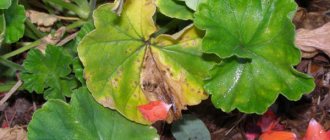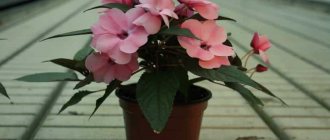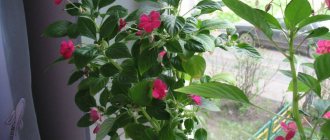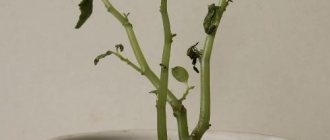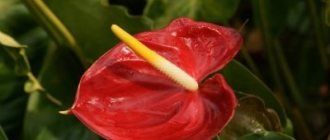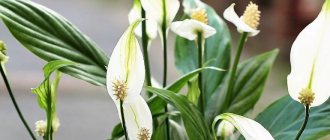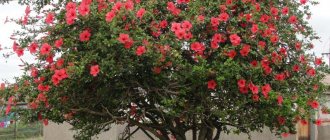Botanical description
The indoor flower Ivan wet grows up to half a meter in height. Its stems are erect, branched, and smooth. The leaves are oval or lanceolate, with small teeth along the edges. Foliage color is purple-bronze or green.
The buds are formed in the axils of the leaves. In cultivation there are varieties with a variety of colors, with the exception of the blue tint. Flowers simple or double. After pollination, green fruits are set; as they ripen, they turn into a dry seed capsule.
Why is the flower called this and what is the correct scientific name? The home flower Vanka wet has other names. All of them are due to the properties of the plant. If you touch a ripe seed pod, it will immediately open the valves and shoot out seeds. For this reason, balsam impatiens was nicknamed “touchy.” Another name – “light” – is associated with bright and abundant flowering.
In reviews, experienced flower growers write that balsam does not tolerate cramped spaces on the windowsill. It grows much better separately, without proximity to other plants.
What kind of plant is this?
Titles
It is correct to call plants that belong to only one species of the genus Impatiens - Impatiens vulgaris - balsam.
However, plants belonging to all species of the genus Impatiens of the Balsamaceae family are sometimes called balsam. There are about 500 types of such species. Impatiens is an annual and perennial herbaceous plant with a fleshy straight stem . Less commonly it is found in the form of a subshrub. It is sometimes called "impatiens", which means "sensitive" in Latin. People use the names “Vanka wet” and “touchy-touchy”.
Another popular name - “light” - is associated with a beautiful romantic legend about a brave guy who did not return from battle. However, a girl of incredible beauty still waited for him for the rest of her life. After her death, a plant with bright, alluring flowers appeared in the house where she lived.
In Germany they call him “zealous Lisa”, in England - “busy Lisey”. There is also the name “beautiful wreath”, which was given to the flower, compared with the blooming and bright resident of Vienna.
Where is his homeland?
Balsam is native to the tropics and subtropics, namely some regions of Asia and Africa. Now, in addition to these areas, it is widespread in Europe, where it was introduced at the end of the 16th century, and in North America.
Description
Flowers of impatiens growing in the house begin to appear in May and delight with their beauty until December. There are two types of balsam fruit :
- a juicy, multi-seeded capsule that suddenly opens from a light touch (this is why the flower in Russia is called “touch-me-not”);
- berry-like fruit.
The root of this plant is very branched. Impatiens shoots branch, forming a thick green cap up to 50 cm high.
The ovoid or oval leaves of balsam are attached to the stem. Their size is approximately 8-12 cm. Their color is green, but it is sometimes bronze or purple. The leaves are either serrated or entire. Their surface is shiny, as if covered with a greasy coating. At high humidity, grains similar to wet sugar appear on the leaves (this fact explains the popular name “Vanka wet”).
Popular types and varieties
According to various sources, the number of balsam genus ranges from 400 to 550 species. The most common traditional varieties are spreading bushes with red and white flowers.
Gradually, they began to be replaced by new hybrid varieties - they are distinguished by more compact, dense bushes, abundant flowering, and new colors. Variegated (variegated) forms of the plant belong mainly to New Guinea hybrids. The most common are four varieties.
- Waller's balsam. The form includes several different hybrid varieties with similar characteristics. The height of the bush is up to half a meter or slightly higher. The stems are bare, highly branched, thick. Thin leaves are held on long petioles. The flowers are separate, large, located at the ends of the shoots. The coloring is different. There are terry forms.
- Peters' balsam. Quite a tall, bushy plant. Stems slightly pubescent. The color of the ground part has a bronze tint. Flowers are fiery in color, on long stalks.
- Niamey balsam. Bush up to a meter tall, with long, branched stems. The leaves are oblong, densely located on the stem. Buds on long stalks are formed in the leaf axils. The flowers are predominantly red. There are two-color varieties with an admixture of yellow splashes.
- New Guinea balsam. Includes a group of tall and compact perennials. The flowers are of different shades, the leaves are quite large.
Wet vanilla (balsam) will bloom more profusely if you regularly pinch the shoots. Due to this, branching increases and more buds are laid. Dwarf varieties of balsam do not need to be pinched.
Let's learn about balsam
What does the plant look like?
This plant looks like a spherical shrub with a height of 20 centimeters to 2 meters , it depends on the variety.
The stem has many succulent and translucent branches on which fleshy leaves grow, with waves along the edges. Colored green or reddish. There are varieties of balsam whose leaves have a terry surface.
flowers delight the eye with a variety of colors and shades, from white and pale pink to defiant red. The red variety was called “light”. Delicate flowers with spur-like shoots cover the entire surface of the bush during flowering.
The seed pods of this plant are true impatiens; when touched, they open and the seeds inside scatter in all directions.
Dew drops on balsam petals
The history and birthplace of the flower
Impatiens have been known for a long time; the plant’s homeland is East Africa and Central Asia. Only in the 16th century in European countries did people become acquainted with this flower and fell in love with it.
The first to see it was Queen Elizabeth I of England. The plant was presented to her, and she appreciated its charm.
The flower appeared in Russia only in the 19th century and gained such popularity that its name is mentioned by such writers as Dostoevsky and Ostrovsky. Vanka (Ivan) – wet, this is an exclusively Russian name for impatiens.
Where is it better to plant impatiens - in the garden or at home?
Impatiens are grown both in the garden and at home. For a domestic species, it is important to find a place where it will receive moderate sun, since the plant loves warmth, but not heat.
Impatiens in a pot at home
It needs to be watered a lot and regularly; this is the most basic care for impatiens. Garden varieties are also heat-loving and will not tolerate frost, so they are planted in slightly shaded places, for example under trees, when the danger of cold weather has passed. It is better to plant where there is no strong wind.
Signs and superstitions
Impatiens, so popular among the people, has also gained fame as a flower associated with white magic. It was one of the indicators of family well-being and love in the home.
It was believed that where there is discord, the plant does not take root and withers . Balsam was personified as the patron of men's luck, strength and self-confidence, and was an assistant in material matters.
Only one negative quality was noted in folk signs - it was considered a harbinger of alcoholism and the appearance in the house of a man suffering from a bad habit.
The healing properties of wet vanilla
Balsam is widely used to treat diseases; it has healing properties . During the flowering period it contains an incredible amount of vitamin C, so the flower collected at this time is used as a tonic and anti-inflammatory agent.
Flowers contain large amounts of vitamin C
Tannins and diuretic components were found in the ground part of the bush ; they have a beneficial effect on the genitourinary system of the body, help cope with urolithiasis and relieve swelling. In China, impatiens is used to treat female diseases.
To treat cuts and open wounds, squeeze the juice of the plant, and to relieve pain from rheumatism, take baths with an infusion of the leaves.
Poisonous or not
Although balsam has a wide spectrum of action from a medical point of view, it is poisonous .
Therefore, it must be used with extreme caution, observing the measure and dosage. So you can drink its infusion only in the amount of 2 tablespoons per day and no more. It is prohibited for pregnant women and children in any doses ; moreover, it can stimulate early labor in a woman.
You should also not use impatiens if you have problems in the gastrointestinal tract. An overdose causes nausea, vomiting and other signs of poisoning.
Vertical gardening
In addition to decorating window sills and gardens, the flower is also used in landscape design and for vertical gardening.
Waller's balsam is used for this . A special design is created from 4 stakes driven into the ground and a large plastic mesh is secured around them and a covering material is black lutrasil, on which cuts are made. Soil is poured inside the resulting box and seeds are planted in the holes in the covering material.
Vanka wet in vertical gardening
This is the simplest and most common way to make vertical gardening using this flower, but using imagination and creativity, you can create compositions of any shape and size.
Caring for Vanka wet: what to consider and how to propagate
Impatiens is a relatively easy plant to care for. In an apartment you can create favorable conditions for it, achieving long-term, almost year-round flowering. To do this, you need to follow the recommendations of experienced flower growers.
- Lighting. All balsams love diffused but bright light. Direct sunlight is undesirable - on southern windows the plant is protected with tulle. The optimal location is east or west. Impatiens respond well to frequent airing of the room or moving to the balcony in warm weather. In summer, planting in the ground is allowed with the onset of stable heat. Impatiens do not have a pronounced dormant period, so additional lighting is required in winter.
- Temperature. Impatiens love warmth and can easily withstand heat up to 30˚C. The optimal temperature is considered to be from 20 to 25˚С. In winter, it needs relative coolness of at least 15˚C.
- Watering. In spring and summer, it is recommended to water immediately after the soil surface dries. In autumn and winter, moderate watering is maintained - after the surface layer of soil dries, wait two days. They try to maintain stable soil moisture and use warm, settled water.
- Humidity. At temperatures below 22˚C, balsam adapts to dry air. In hot weather, frequent spraying is needed.
- Feeding. Balanced fertilizers are applied twice a month for beautifully flowering crops. The bulk of fertilizing occurs during the active growing season. If flowering continues in winter, occasionally the balsam can be fed with a half dose of complex fertilizer.
- Trimming. To preserve decorativeness and stimulate flowering, balsam is “cut” in the spring, cutting the stems by a third or half the length. As the side shoots grow, the tops are pinched. Weak, unnecessary branches are pruned at any time of the year.
- The soil. The optimal soil for balsam is a mixture of deciduous soil, humus, turf and sand. All components are taken in equal quantities.
- Transfer. The most favorable time for transplantation is the beginning of spring. Young specimens are replanted every year. If necessary, you can replant in the summer. Many gardeners recommend using the transshipment method.
Wet Vanka does not bloom in bulk containers. To stimulate flowering, the main shoots are shortened and transplanted into a smaller container. When caring for balsam, maintain stable soil moisture - drying out can lead to the death of flower buds and the fall of buds at the stage of their formation.
Possible difficulties, diseases and pests
- If you find white mold on the balsam leaves, let the soil dry and then move the pot to a warm room, the temperature in which will be above +13 C. Spray with fungicide, but not more than once.
- If the leaves become pale and the stems lengthen, your flower urgently needs feeding or replanting. Wait until spring and replant it in fresh soil, fertilize it once a week.
- If the leaves begin to dry out, curl, or fall off, this is a sure sign that your balsam is hot and dry. Move it to a cooler, more humid place
- If the leaves turn pale and fall off, then he is most likely cold. Transfer the flower pot to a warm room where the air temperature is about +18 C.
- If the leaves of the wet Vanka become small, the flower is attacked by aphids. Spray it every two weeks with an insecticide until the pests die.
Reproduction methods
Flower growers practice seed and vegetative propagation. Both methods are effective, but sowing seeds from a hybrid plant can give unexpected results - the main characteristics of the variety change. To obtain seedlings of a certain variety, store-bought seeds are often used.
Seeds
The favorable period for seed propagation is spring. But if you sow the seeds in February, you can get a beautiful flowering bush in May. A mixture of sand and peat is used as a substrate. To obtain strong seedlings, a certain sequence of actions is followed.
- Seed preparation. Planting material is soaked for ten minutes in a weak solution of potassium permanganate, washed and filled with warm water for an hour. The seeds are slightly dried.
- Landing. The container is filled with pre-prepared substrate. Seeds are distributed over its surface and sprinkled with a thin layer of fine sand on top. The container is covered with film.
- Conditions for germination. Maintain a stable temperature in the range of 18–20 ˚С. Once every two days, open the greenhouse, remove excess condensation, and moisten the soil with a spray bottle as necessary. If possible, install additional lighting.
- Picking. After two true leaves appear, the seedlings can be planted in separate small pots.
- Topping. At the stage of five to nine leaves, the young plant is pinched to stimulate branching.
Cuttings
Reproduction of Vanka wet by cuttings allows you to quickly grow a young plant to replace the old one. Cuttings are specially cut or the apical shoots remaining after spring pruning are used. Rooting is carried out in the following sequence.
- Preparation of cuttings. The optimal cutting length is 5–6 cm. The upper leaves are cut in half, the lower leaves are cut off completely.
- Root growth. The cuttings are placed in water with the addition of activated carbon tablets and root formers.
- Landing in the ground. After the roots have formed, the cuttings are placed in light soil. They are kept under film for a week to smooth out temperature changes and maintain stable humidity.
- Topping. The growing point of a young plant is pinched to stimulate branching.
The bush can be made more lush if several cuttings or seedlings are planted in one pot at once. A distance of about 5 cm must be maintained between plants. Flower growers recommend planting seedlings of the same variety in a common pot.
Possible growing difficulties
Unsuitable soil, microclimate, and errors in maintenance conditions immediately affect the appearance of balsam. You can familiarize yourself with care errors and their consequences in the table.
Table - Possible difficulties when growing balsam
| External manifestation | Main reasons | Help the plant |
| Vanka's wet leaves are turning yellow | – Dry air; – waterlogging of the soil; – root rotting; – excess fertilizer | – Check the root system for rot; – adjust the care regimen |
| The leaves are drooping | - Heat; – lack of moisture | – In hot weather, balsam is sprayed; – water regularly, avoiding stagnation of moisture |
| Vanya's wet buds are falling off | – Dry air; – excess fertilizer; - cold; – soil drying out; – pest invasion | – During flowering, balsam is kept in moderate heat; – water regularly; – dilute the fertilizer according to the instructions |
| Variegated forms lose their characteristic color | – Lack of light; – excess fertilizer | – Move the balsam to a bright place or install additional lighting |
| Leaves fall, flowering stops | – Lack of light combined with low temperature; | – Until the end of flowering, maintain a stable temperature of at least 20˚С |
| Leaves become smaller, stems become longer | – Cramped pot; – lack of nutrients; – poor lighting; – heat | – The balsam is cut off and transplanted into a larger pot; – adjust the conditions of detention |
| Leaves curl and fall | – Cool content combined with waterlogging of the soil | – Reduce watering; – increase the temperature of the contents |
If the balsam suddenly turns yellow, wilts and begins to shed its leaves, this is a sure sign of stress. Its condition is negatively affected by drafts, sudden temperature changes, and changes in lighting intensity.
Types of impatiens
There are not many types of balsam:
- Impatiens Wallera, or Impatiens Wallera, is the most common species, from which many hybrids have been developed (Stardust, Frosty, Symphony, Futura, Super Elfin, King Kong, Novette, Confection, Double Duet, Rosette, Fiesta, Candy, Stardust Lavender, Fanciful Tropical ).
- Hawker impatiens.
- Impatiens niamayensis (Nianiana). Its variety, Impatiens corduroy, with slipper-shaped flowers, is especially loved among flower growers.
- Impatiens Peters.
- Ironbearing impatiens.
- Impatiens impatiens, or garden balsam, or Impatiens impatiens.
- Tamarind impatiens. Varieties Rosette, Fiesta, Double Duet, Stardust Lavender are popular due to their double flowers.
- Balfour impatiens.
Common diseases
Even if you live in an apartment, you cannot avoid some diseases. Infections are spread by pests, and the fungus can live in poor-quality soil. The table describes balsam diseases and their treatment.
Table - Diseases of balsam
| Name and cause of the disease | External manifestations | Treatment |
| Cucumber mosaic (virus) | – Leaves become wavy; – yellow spots and holes appear | – The plant is isolated and destroyed |
| Ring mosaic (virus) | – Round spots with a ring border appear on the foliage; – growth slows down; – leaves crack | |
| Brown rot (fungus) | – The stem becomes thin at the base and turns brown | – At the initial stages of the disease, they are sprayed repeatedly with the drug “Fitosporin”; – in case of severe damage, the balsam is destroyed |
| Downy mildew (fungus) | – Light spots form on the outside of the leaves; – the back side of the leaves is covered with a dirty whitish coating | – Trim the affected tissues; – sprayed with “Alyet” |
| Bacteriosis (bacteria) | – Black spots appear on the foliage | – Carry out pruning; – sprayed repeatedly with fungicides |
Frequent pests
Impatiens are susceptible to attacks by many pests of indoor flowers. Fungus gnats, aphids, and spider mites are especially dangerous. More detailed information about pests is given in the table.
Table - Pests of balsam
| Pest | Symptoms | Fighting methods |
| Spider mite | – Yellow specks appear on the foliage; – the balsam withers and becomes covered with cobwebs; – the upper leaves are deformed | – Balsam is treated with soap, rinsed under a warm shower; – often sprayed; – increase the humidity in the room; – treated with “Aktellik”, “Aktara” products |
| Whitefly | – Leaves are deformed; – the plant turns yellow and withers | – The bush is washed with warm water; – hang special glue traps; – sprayed with preparations “Mospilan”, “Fufanon”, “Confidor” |
| Thrips | – Leaves lose their shape, become discolored, and acquire a silvery tint; – brown spots appear on the back side; – holes form on the petals; - pollen falls | – Repeatedly, with weekly breaks, sprayed with insecticides “Fitoverm”, “Vermitek” |
| Aphid | – Colonies of sedentary insects appear on young shoots; – leaves curl and become discolored; – flowering stops; - the plant withers, withers | – Treat all damaged shoots with soap; – spray with infusion of pine needles and tobacco dust; – in difficult cases, the drugs “Actellik” and “Karbofos” are used |
| Shchitovka | – Brown plaques appear on the stems; – individual shoots die | – Scale insects are removed with an alcohol wipe; – the plant is sprayed with any insecticide, covered with a bag overnight |
| Fools | – Impatiens withers and stops growing due to damage to the root system | – Water the soil with the preparation “Thunder” |
| Sciarids (fungus gnats) | – Small midges, similar to mosquitoes, fly over the flower; – the plant dies due to damage to the root system by larvae | – Impatiens are replanted with soil replacement; – the soil is spilled with the preparation “Fly-eater”; – “Raptor”, “Dichlorvos” aerosol is sprayed around the plant |
If you properly care for the Vanka wet flower, the likelihood of infection by pests and diseases will be minimized. In favorable conditions, balsam will bloom almost all year round.
